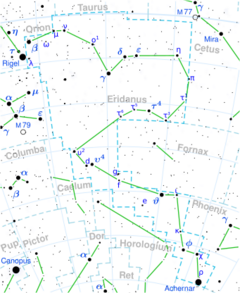Astronomy:Gamma Eridani
| Observation data Epoch J2000.0 Equinox (celestial coordinates) | |
|---|---|
| Constellation | Eridanus |
| Right ascension | 03h 58m 01.76695s[1] |
| Declination | −13° 30′ 30.6698″[1] |
| Apparent magnitude (V) | 2.88 - 2.96[2] |
| Characteristics | |
| Evolutionary stage | AGB[3] |
| Spectral type | M0III-IIIb[4] |
| U−B color index | +1.96[5] |
| B−V color index | +1.58[5] |
| Variable type | Lb?[2] |
| Astrometry | |
| Radial velocity (Rv) | 60.81±0.25[6] km/s |
| Proper motion (μ) | RA: +61.57[1] mas/yr Dec.: −113.11[1] mas/yr |
| Parallax (π) | 17.0016 ± 0.2254[7] mas |
| Distance | 192 ± 3 ly (58.8 ± 0.8 pc) |
| Absolute magnitude (MV) | −1.19[8] |
| Details | |
| Radius | 80[6] R☉ |
| Luminosity | 1,259[6] L☉ |
| Surface gravity (log g) | 1.0[6] cgs |
| Temperature | 3,811[6] K |
| Rotational velocity (v sin i) | 3.8[6] km/s |
| Other designations | |
Zaurac, Gamma Eridani, Gamma Eri, γ Eridani, γ Eri, 34 Eridani, 34 Eri, HD 25025, HIP 18543, HR 1231[9] | |
| Database references | |
| SIMBAD | data |
Gamma Eridani (γ Eridani, abbreviated Gamma Eri, γ Eri), formally named Zaurak /ˈzɔːræk/,[10][11] is a variable star in the constellation of Eridanus. It is visible to the naked eye with an apparent visual magnitude that varies around 2.9, and lies at a distance of about 203 light years from the Sun, as determined by the Hipparcos astrometry satellite.
Description
Gamma Eridani has been defined as a standard star for the spectral class M0III-IIIb.[4] It is a red giant on the asymptotic giant branch, fusing hydrogen and helium in separate shells outside its core.[3] Observations published in 1960 showed it to vary in brightness by a few hundredths of a magnitude.[13] In 1977, it was officially listed as a variable star in the General Catalogue of Variable Stars although the class of variable is uncertain.[14]
Nomenclature
Gamma Eridani is the star's Bayer designation. It has the traditional name Zaurak, alternatively spelled Zaurac, which is one of the Persian words for 'boat'.[15] In 2016, the International Astronomical Union organized a Working Group on Star Names (WGSN)[16] to catalog and standardize proper names for stars. The WGSN's first bulletin of July 2016[17] included a table of the first two batches of names approved by the WGSN; which included Zaurak for this star.
In Chinese, 天苑 (Tiān Yuàn), meaning Celestial Meadows, refers to an asterism consisting of γ Eridani, δ Eridani, π Eridani, ε Eridani, ζ Eridani, η Eridani, π Ceti, τ1 Eridani, τ2 Eridani, τ3 Eridani, τ4 Eridani, τ5 Eridani, τ6 Eridani, τ7 Eridani, τ8 Eridani and τ9 Eridani.[18] Consequently, the Chinese name for γ Eridani itself is 天苑一 (Tiān Yuàn yī, English: the First [Star] of Celestial Meadows.)[19]
USS Zaurak (AK-117) was a United States Navy Crater class cargo ship named after the star.
References
- ↑ 1.0 1.1 1.2 1.3 van Leeuwen, F. (2007), "Validation of the new Hipparcos reduction", Astronomy and Astrophysics 474 (2): 653–664, doi:10.1051/0004-6361:20078357, Bibcode: 2007A&A...474..653V.
- ↑ 2.0 2.1 Samus, N. N.; Durlevich, O. V. et al. (2007), Combined General Catalogue of Variable Stars (GCVS4.2), http://www.sai.msu.su/gcvs/gcvs/. VizieR On-line Data Catalog: B/gcvs.
- ↑ 3.0 3.1 Eggen, O. J. (1992), "Asymptotic giant branch stars near the sun", The Astronomical Journal 104: 275, doi:10.1086/116239, Bibcode: 1992AJ....104..275E.
- ↑ 4.0 4.1 Keenan, P.; McNeil, R. (October 1989), "The Perkins catalog of revised MK types for the cooler stars", Astrophysical Journal Supplement Series 71: 245–266, doi:10.1086/191373, Bibcode: 1989ApJS...71..245K.
- ↑ 5.0 5.1 Mermilliod, J.-C. (1986), "Compilation of Eggen's UBV data, transformed to UBV (unpublished)", Catalogue of Eggen's UBV Data (SIMBAD), Bibcode: 1986EgUBV........0M.
- ↑ 6.0 6.1 6.2 6.3 6.4 6.5 Massarotti, Alessandro et al. (January 2008), "Rotational and radial velocities for a sample of 761 HIPPARCOS giants and the role of binarity", The Astronomical Journal 135 (1): 209–231, doi:10.1088/0004-6256/135/1/209, Bibcode: 2008AJ....135..209M.
- ↑ Brown, A. G. A. (2021). "Gaia Early Data Release 3: Summary of the contents and survey properties". Astronomy & Astrophysics 649: A1. doi:10.1051/0004-6361/202039657. Bibcode: 2021A&A...649A...1G. Gaia EDR3 record for this source at VizieR.
- ↑ Cardini, D. (January 2005), "Mg II chromospheric radiative loss rates in cool active and quiet stars", Astronomy and Astrophysics 430: 303–311, doi:10.1051/0004-6361:20041440, Bibcode: 2005A&A...430..303C.
- ↑ "* gam Eri". SIMBAD. Centre de données astronomiques de Strasbourg. http://simbad.u-strasbg.fr/simbad/sim-basic?Ident=%2A+gam+Eri.
- ↑ Kunitzsch, Paul; Smart, Tim (2006), A Dictionary of Modern star Names: A Short Guide to 254 Star Names and Their Derivations (2nd rev. ed.), Cambridge, Massachusetts: Sky Pub, ISBN 978-1-931559-44-7.
- ↑ IAU Catalog of Star Names, http://www.pas.rochester.edu/~emamajek/WGSN/IAU-CSN.txt, retrieved 28 July 2016.
- ↑ Hipparcos Tools Interactive Data Access, ESA, https://www.cosmos.esa.int/web/hipparcos/interactive-data-access, retrieved 8 December 2021.
- ↑ Cousins, A. W. J. (1960), "New Bright Variable Stars", Monthly Notes of the Astronomical Society of Southern Africa 19: 56, Bibcode: 1960MNSSA..19...56C.
- ↑ Kukarkin, B. V.; Kholopov, P. N.; Fedorovich, V. P.; Kireyeva, N. N.; Kukarkina, N. P.; Medvedeva, G. I.; Perova, N. B. (1977), "62nd Name-List of Variable Stars", Information Bulletin on Variable Stars 1248: 1, Bibcode: 1977IBVS.1248....1K.
- ↑ Allen, R. H. (1963), Star Names, Dover, p. 218, https://penelope.uchicago.edu/Thayer/E/Gazetteer/Topics/astronomy/_Texts/secondary/ALLSTA/Eridanus*.html, retrieved 2016-10-09.
- ↑ IAU Working Group on Star Names (WGSN), IAU, https://www.iau.org/science/scientific_bodies/working_groups/280/, retrieved 2016-05-22
- ↑ Bulletin of the IAU Working Group on Star Names, No. 1, http://www.pas.rochester.edu/~emamajek/WGSN/WGSN_bulletin1.pdf, retrieved 2016-07-28.
- ↑ (in Chinese) 中國星座神話, written by 陳久金. Published by 台灣書房出版有限公司, 2005, ISBN:978-986-7332-25-7.
- ↑ (in Chinese) 香港太空館 - 研究資源 - 亮星中英對照表 , Hong Kong Space Museum. Accessed on line November 23, 2010.
 |



